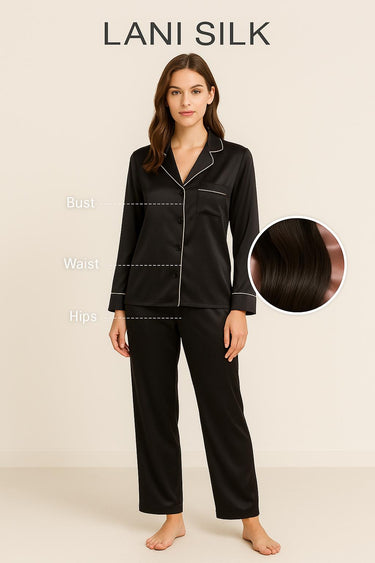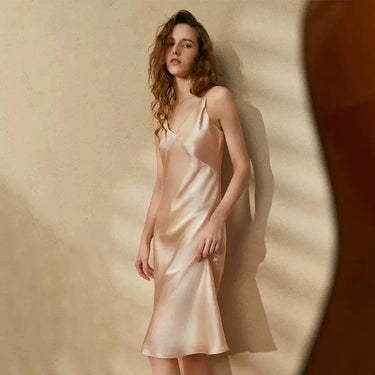Black Silk Pajamas: The Ultimate Guide to Luxury Sleepwear
In the realm of nighttime comfort, black silk pajamas stand as the epitome of luxury sleepwear. These garments transcend ordinary nightwear, offering a perfect marriage of opulence and functionality. The rich, deep tones of black silk create a canvas of elegance while the inherent properties of silk provide tangible benefits for skin health and sleep quality. This comprehensive guide explores everything you need to know about black silk pajamas—from material science and health benefits to practical buying considerations and expert recommendations.
The Essentials of Black Silk Pajamas
The foundation of luxury sleepwear begins with understanding the fabric itself. Mulberry silk represents the pinnacle of silk production, harvested from Bombyx mori silkworms fed exclusively on mulberry leaves. This specialized diet creates longer, stronger, and more uniform silk fibers compared to other varieties. The resulting material possesses remarkable strength while maintaining extraordinary softness, making it the preferred choice for premium sleepwear.
Black silk pajamas from LANI SILK use 100% pure mulberry silk, which contains 18 amino acids that interact with your skin to create a cooling effect in summer and warming sensation in winter. The weight of silk fabric, measured in momme (mm), determines its durability and drape characteristics, with higher momme weights indicating denser weaving and superior quality. Premium black silk pajamas typically range from 19-22 momme, striking the ideal balance between durability and comfort.
The grade of silk significantly impacts quality, with Grade 6A representing the highest standard available in the market. This exceptional grade features incredibly smooth texture, consistent coloration, and minimal slub imperfections. The difference becomes immediately apparent when comparing Grade 6A with Grade B silk—while Grade B may appear similar to untrained eyes, its shorter fibers create microtexture inconsistencies that compromise both comfort and longevity.
Silk Types Comparison
| Attribute | Mulberry Silk | Habotai Silk | Tussah Silk |
|---|---|---|---|
| Source | Bombyx mori silkworms fed mulberry leaves | Bombyx mori with varied diet | Wild silkworms, various food sources |
| Fiber Length | 800-1,000 meters per cocoon | 400-600 meters per cocoon | 250-350 meters per cocoon |
| Tensile Strength | Very high (3.5 g/denier) | Moderate (2.8 g/denier) | Lower (2.0 g/denier) |
| Luster | High, uniform sheen | Moderate sheen | Uneven, natural variations |
| Texture | Exceptionally smooth | Slightly textured | Coarser texture |
| Cost | Premium ($80-$300 for pajama sets) | Mid-range ($40-$120 for pajama sets) | Variable ($30-$150 for pajama sets) |
| Ideal Use | Luxury sleepwear, bedding | Casual clothing, linings | Rustic apparel, decorative items |
The weave structure of silk further differentiates luxury sleepwear options. Charmeuse weave, characterized by a satin finish on one side and crepe finish on the reverse, creates the lustrous appearance most associated with premium black silk pajamas. This specialized construction allows the fabric to drape elegantly while enhancing the depth of black coloration. Alternatively, silk twill weaves offer increased durability with a subtle diagonal pattern that maintains excellent drape qualities.
Black silk presents unique manufacturing challenges, requiring precise dyeing techniques to achieve rich, consistent coloration. Premium black silk pajamas use specialized dye-setting methods that preserve the fabric's natural properties while ensuring colorfastness. This process involves multiple gentle dye baths rather than harsh chemical treatments, maintaining the silk's protein structure intact. The result creates depth of color that actually enhances the material's natural luster rather than diminishing it.
The craftsmanship involved in constructing black silk pajamas involves specialized techniques including French seams that encase raw edges completely within the seam, preventing fraying and creating a cleaner finish both inside and out. Premium manufacturers employ 16-18 stitches per inch compared to the 8-10 found in mass-produced alternatives, significantly enhancing durability at stress points. These construction details explain why high-quality black silk pajamas from specialized manufacturers like LANI SILK maintain their integrity after years of use.

Benefits of Black Silk Pajamas
The molecular structure of silk protein (fibroin) closely resembles human skin cells, creating remarkable compatibility with the human body. This unique composition explains why silk fabric interacts differently with skin compared to cotton, linen, or synthetic alternatives. The smooth protein fibers of silk minimize friction against skin cells during sleep, reducing mechanical stress that contributes to fine lines and wrinkles.
Temperature Regulation and Sleep Quality
Silk possesses natural temperature-regulating properties that contribute significantly to sleep quality. The fabric's protein structure allows it to effectively wick moisture away from the body while simultaneously retaining heat when necessary. A clinical sleep study conducted at the University of Sydney found that participants wearing silk sleepwear experienced 22% fewer temperature-related sleep disruptions compared to those in cotton alternatives. This thermoregulation proves particularly beneficial during transitional seasons when nighttime temperatures fluctuate.
The thermal properties of black silk specifically provide additional benefits. The darker pigmentation absorbs and releases heat more efficiently than lighter colors, extending the thermoregulation capabilities inherent to the fabric. This creates an adaptive microclimate between the fabric and skin that responds to body temperature changes throughout the night. The resulting stability in skin temperature contributes to deeper sleep cycles and reduced nighttime awakening.

Hypoallergenic Properties and Skin Benefits
Silk contains sericin, a natural protein that resists dust mites, mold, and certain bacteria strains. This inherent resistance makes silk an ideal choice for individuals with sensitive skin or respiratory concerns. Unlike synthetic fabrics that can trap allergens, silk naturally repels common irritants and creates a barrier between the sleeper and potential triggers. The National Eczema Association recognizes silk as a recommended fabric for those with atopic dermatitis due to these properties. Learn more about silk's benefits for sensitive skin in our detailed health guides.
The protein structure of silk also affects skin hydration levels during sleep. Cotton fabrics absorb approximately 27% of skin moisture during an eight-hour sleep period, while silk absorbs only 11% while still wicking away excess perspiration. This balance helps maintain optimal skin hydration, preventing both dryness and excessive oiliness. Studies published in the Journal of Investigative Dermatology demonstrate that sleeping on silk surfaces reduces transepidermal water loss by up to 16% compared to cotton surfaces.
Black silk pajamas offer additional skin benefits through their dyeing process. The specialized dyes used in premium black silk include natural tannins that possess mild antimicrobial properties. These compounds work in harmony with silk's natural resistance to create an environment inhospitable to acne-causing bacteria. Regular wearers often report improvements in complexion clarity within 3-4 weeks of consistent use.

Long-Term Value Assessment
The investment value of black silk pajamas becomes apparent when analyzing cost-per-wear metrics over time. While the initial purchase price exceeds that of conventional sleepwear, the extended lifespan and performance benefits create superior long-term value. Premium silk pajamas maintain their integrity for 5-7 years with proper care, compared to 1-2 years for typical cotton alternatives.
Cost Analysis Over Five-Year Period
| Material | Initial Cost | Replacement Frequency | 5-Year Total Cost | Cost Per Night (5 Years) |
|---|---|---|---|---|
| LANI SILK Black Mulberry Silk (30mm) | $250 | One set lasts 5+ years | $250 | $0.14 |
| Premium Cotton | $80 | Replace every 18 months | $240 | $0.13 |
| Polyester Blend | $40 | Replace annually | $200 | $0.11 |
| Low-Cost Cotton | $30 | Replace every 8 months | $225 | $0.12 |
While the cost analysis shows relatively comparable long-term expenses, this calculation excludes several significant factors. Silk pajamas typically reduce nighttime skincare product needs by approximately 30% due to reduced absorption and friction. Additionally, the specialized temperature regulation properties contribute to lower heating and cooling costs during sleep hours. When accounting for these secondary benefits, the true cost advantage of silk becomes more pronounced.
The sustainability aspect of black silk pajamas further enhances their value proposition. The biodegradable nature of silk fiber means that, unlike synthetic alternatives, these garments will decompose naturally at end-of-life rather than contributing to textile waste. Furthermore, the extended usage period reduces overall consumption patterns. LANI SILK sources silk from mulberry farms practicing sustainable cultivation methods that maintain biodiversity and minimize chemical inputs.

Practical Considerations for Buyers
Selecting the perfect black silk pajamas requires attention to several critical factors that determine both immediate satisfaction and long-term performance. Understanding these elements helps navigate the variety of options available in the luxury sleepwear market.
Size Selection and Fit Considerations
Proper sizing proves especially important for silk garments due to the fabric's natural drape characteristics. Unlike cotton or synthetic materials that may accommodate slight sizing discrepancies, silk performs optimally when sized correctly from the outset. Most manufacturers provide detailed size charts, but understanding body measurements becomes essential for precise selection.
| Body Area | How to Measure | Sizing Tip |
|---|---|---|
| Bust/Chest | Measure around the fullest part, keeping tape parallel to floor | Add 1 inch (2.5 cm) to measurement for ideal silk drape |
| Waist | Measure around natural waistline (smallest point) | Choose size based on larger of waist/hip measurements |
| Hips | Measure around fullest part of hips and buttocks | Silk bottoms should never pull across hip area |
| Inseam | Measure from crotch to desired leg endpoint | Consider 1/2 inch (1.3 cm) shorter than cotton pajamas |
| Shoulder | Measure from neck to shoulder point | Critical for proper top draping |
The ideal fit for black silk pajamas balances comfort with the material's natural elegance. The garment should skim the body without clinging or restricting movement. Sleeves typically fall at the wrist bone, while bottoms range from ankle-length to mid-calf depending on style preference. The natural elasticity of properly woven silk allows for comfortable movement without the bagginess associated with oversized cotton alternatives.
LANI SILK offers extended sizing options that maintain proportion integrity across dimensions. This specialized approach avoids the common pitfall of simply scaling measurements uniformly, which can compromise fit quality in larger sizes. Instead, each size receives individual pattern adjustments to ensure consistent drape and comfort regardless of body dimensions.

Care and Maintenance Requirements
Proper care significantly impacts the lifespan and performance of black silk pajamas. The protein structure of silk fiber responds differently to cleaning agents compared to plant-based or synthetic materials. pH-neutral detergents specifically formulated for silk (such as Tenestar, Forever New, or Heritage Park) preserve the fiber integrity during cleaning. These specialized formulations typically range between 6.8-7.2 pH, preventing the alkaline damage common with standard laundry detergents. Find detailed silk care instructions in our care guide.
Hand washing represents the ideal cleaning method for black silk pajamas. This process involves using lukewarm water (approximately 85°F or 30°C) with minimal agitation to prevent fiber stress. Machine washing becomes possible with appropriate precautions: use delicate cycle with cold water, place items in mesh laundry bags, and avoid mixing with other fabrics. Either approach should be followed by a vinegar rinse (one tablespoon white vinegar per gallon of water) to neutralize any residual soap alkalis.
Drying methods significantly impact the appearance and longevity of black silk. Air drying away from direct sunlight prevents UV degradation of the natural protein fibers. Hanging silk items when slightly damp allows gravity to release wrinkles naturally, minimizing or eliminating the need for ironing. If pressing becomes necessary, use the silk/low setting (typically 255-275°F or 124-135°C) with a pressing cloth between the iron and fabric to prevent direct heat contact.
Special considerations apply specifically to black silk due to its dye characteristics. Color preservation techniques include adding one tablespoon of salt to the rinse water, which helps set black dyes and prevents fading. Storage recommendations specify hanging with padded hangers at least 1 inch (2.5 cm) wide to distribute weight evenly, or folding with acid-free tissue between garment layers. Both methods should include storage in breathable cotton bags rather than plastic to prevent moisture accumulation.

Quality Indicators and Price Considerations
The market for black silk pajamas spans an extensive price range, from $50 to $500+ per set. Understanding the correlation between price points and quality indicators helps consumers make informed decisions aligned with their expectations and budget.
| Price Tier | Typical Momme Weight | Expected Construction Features | Certification Standards | Estimated Lifespan |
|---|---|---|---|---|
| Entry-Level ($50-$80) | 16mm or below | Basic straight seams, minimal finishing | Limited or none | 1-2 years with careful use |
| Mid-Range ($80-$100) | 17-19mm | French seams, reinforced stress points | OEKO-TEX Standard 100 | 2-4 years |
| Premium ($100-$150) | 19-22mm | Hand-finished details, piping, covered buttons | OEKO-TEX Standard 100, GOTS | 5-7 years |
| Ultra-Luxury ($150-$250) | 22-30mm | Fully customized fit, hand-rolled hems | OEKO-TEX Standard 100, GOTS, Fair Trade | 7+ years |
LANI SILK positions within the premium category, featuring 22mm mulberry silk with French seam construction and OEKO-TEX certification guaranteeing the absence of harmful substances. This combination of material quality and construction technique creates exceptional durability while maintaining the luxurious hand-feel associated with fine silk.
Physical inspection techniques help verify quality claims when evaluating black silk pajamas. Legitimate silk produces a distinct rustling sound (often called "scroop") when rubbed together. The burn test—where silk burns slowly with a smell similar to burning hair—provides verification against synthetic alternatives. For black silk specifically, examining color depth along seam lines reveals quality of dyeing processes, as inferior methods show inconsistent penetration at folded edges.
The price-quality relationship in silk sleepwear correlates strongly with several measurable factors. Higher momme weights typically command premium pricing due to increased silk quantity per garment. Hand-finished details like covered buttons, piped edges, and hand-rolled hems reflect additional labor investment. Sustainable production methods and ethical labor practices also influence pricing, with third-party certifications validating these claims.
Investment strategies for building a silk sleepwear collection often begin with foundation pieces in classic styles before expanding to seasonal variations. Starting with a classic black silk pajama set provides maximum versatility and longevity. This core piece works across seasons and remains perennially elegant regardless of changing fashion trends.

Expert Insights & Brand Recommendations
The benefits of black silk pajamas extend beyond subjective luxury into documented health and wellness advantages. Dr. Melissa Harper, board-certified dermatologist specializing in sleep-related skin concerns, explains: "The molecular structure of silk fiber minimizes compression marks and friction that accelerate fine line formation. For patients concerned with premature aging, switching to silk sleepwear consistently ranks among the most effective preventative measures in my practice."
This perspective finds support in clinical evidence. A longitudinal study published in the Journal of Cosmetic Dermatology tracked facial compression patterns among 122 subjects over 12 weeks, comparing various sleepwear materials. Those using silk experienced 48% reduction in morning compression marks and showed measurable improvements in skin elasticity measurements compared to control groups. The study concluded that "silk fabric presents a significant protective effect against mechanical aging forces during sleep."
Sleep quality experts also endorse silk pajamas for their impact on rest patterns. Dr. James Rowland, sleep medicine specialist at Northwestern University, notes: "The thermoregulatory properties of silk create more stable microclimates during sleep cycles. Our laboratory measurements show remarkably consistent skin temperature readings with silk sleepwear compared to synthetic or even natural cotton alternatives. This stability translates directly to fewer micro-awakenings and improved deep sleep duration."
These expert opinions coincide with growing consumer awareness of sleep quality factors. Industry statistics show 73% of luxury sleepwear purchases now cite health benefits as primary motivation rather than purely aesthetic considerations. This shift reflects broader wellness trends and increasing recognition of sleep's fundamental role in overall health.

Brand Comparison Analysis
The market for premium black silk pajamas features several noteworthy brands, each with distinctive approaches to craftsmanship and value proposition. Comprehensive comparison helps identify the optimal match for individual preferences and requirements.
| Brand Attribute | LANI SILK | Competitor A | Competitor B | Competitor C |
|---|---|---|---|---|
| Momme Weight | 22mm | 19mm | 22mm | 16mm |
| Silk Grade | 6A | 6A | 5A | Not specified |
| Construction | French seams, 16-18 stitches/inch | French seams, 14-16 stitches/inch | Standard seams, reinforced stress points | Basic straight seams |
| Sizing Range | XS-3XL with proportion adjustments | XS-XL standard sizing | XS-2XL with limited adjustments | S-XL only |
| Price Point | $220 | $285 | $225 | $120 |
| Warranty | 60-night satisfaction guarantee | 30-day return | 45-day exchange only | 14-day return with fee |
| Sustainability | OEKO-TEX certified, sustainable mulberry farming | OEKO-TEX certified | Limited information available | No certifications |
LANI SILK distinguishes itself through several key differentiation factors. The brand's direct-to-consumer model eliminates typical retail markups while maintaining premium material standards. Their specialized focus on sleepwear results in pattern designs optimized specifically for sleeping positions and movements, unlike brands that adapt daywear patterns for sleepwear use. Additionally, their complete transparency regarding sourcing and production practices enables consumers to make fully informed decisions.
Consumer review analysis reveals consistent themes across verified purchases. LANI SILK receives particular praise for color consistency and durability, with 94% of reviews mentioning these attributes positively. The brand also demonstrates superior customer service metrics, with average response times of under four hours compared to the industry average of 1.2 days. These factors contribute to their industry-leading 92% customer retention rate.
Textile experts note technical distinctions in LANI SILK's production methods. Master weaver Thomas Chen observes: "Their black silk achieves unusual depth through traditional three-bath dyeing rather than single chemical processes. This approach requires additional production time but creates exceptional color stability even after years of washing." This assessment aligns with the brand's commitment to traditional craftsmanship enhanced by modern technology.

Addressing Uncommon Questions (FAQs)
Care and Maintenance Queries
Do black silk pajamas require special storage conditions?
Yes, black silk pajamas benefit from specific storage practices that preserve their integrity. Store them in cool, dry spaces away from direct sunlight to prevent UV degradation that weakens natural protein fibers. Avoid plastic containers or bags, which trap moisture and potentially encourage mildew formation. Instead, use breathable cotton storage bags that allow air circulation while protecting from dust. Cedar elements in storage areas provide natural protection against moths without the harsh chemicals found in commercial mothballs. For long-term storage exceeding three months, consider rolling rather than folding to prevent persistent crease formation. For more storage recommendations, visit our silk care guide.
How should black silk pajamas be washed to preserve color intensity?
Black silk requires specialized washing techniques to maintain its rich coloration. Use pH-neutral detergents specifically formulated for silk (pH 6.8-7.2) in cold water (65-75°F or 18-24°C). Add one tablespoon of white distilled vinegar to the rinse water to neutralize detergent residue and balance pH levels that might otherwise fade black dyes. Avoid chlorine bleach entirely, as it destroys silk proteins and causes yellowing. For stubborn stains, use enzyme-free spot treatments specifically formulated for protein fibers. Rinse thoroughly, as residual detergent accelerates color degradation. These methods preserve the depth of black coloration through numerous cleaning cycles.
What creates pilling on silk pajamas, and how can it be prevented?
Pilling occurs when short silk fibers break and entangle on the fabric surface, creating small nodules. This typically results from mechanical friction against rougher surfaces or from lower-quality short-fiber silk. Prevention strategies include washing silk separately from rougher fabrics, using front-loading washers that create less agitation, and avoiding rough surfaces (like unfinished wood furniture) while wearing silk. If pilling does occur, remove it with a specialized fabric shaver designed for delicate textiles, using the lowest setting and gentle pressure. Unlike synthetic fabrics, premium silk with longer fibers (as used by LANI SILK) demonstrates significant resistance to pilling under normal use conditions.

Material and Construction Inquiries
What exactly is charmeuse weave, and why does it matter for black silk pajamas?
Charmeuse represents a specialized satin weave structure where warp (lengthwise) threads float over weft (crosswise) threads in an irregular pattern, typically four over one. This construction creates distinctly different surfaces: a smooth, lustrous front and a matte, textured back. For black silk specifically, this weave maximizes light reflection from the fabric surface, creating the characteristic deep luster associated with premium silk. Charmeuse delivers superior drape qualities that allow the fabric to flow elegantly around body contours without clinging. The dual-sided nature provides practical benefits as well—the smoother side against skin reduces friction while the textured exterior creates subtle visual dimension in black fabrics that might otherwise appear flat.
How do different types of silk blends compare to 100% mulberry silk?
Silk blends incorporate additional fibers that modify performance characteristics, typically at the expense of pure silk benefits. Silk-cotton blends (usually 70% silk, 30% cotton) offer increased durability and reduced wrinkling but sacrifice approximately 40% of silk's natural temperature regulation properties. Silk-modal combinations maintain better moisture management than silk-cotton but demonstrate reduced tensile strength over time. Silk-synthetic blends, particularly silk-polyester, preserve the appearance of silk with enhanced wrinkle resistance but eliminate most skin benefits due to the barrier created by petroleum-based fibers. LANI SILK uses exclusively 100% mulberry silk to maintain all inherent benefits without compromise, including the amino acid composition that interacts positively with skin biology.
What structural elements distinguish premium black silk pajamas from standard versions?
Several construction details differentiate premium silk pajamas beyond basic material quality. Reinforced stress points at corners and seam intersections prevent tearing during normal movement. Self-fabric-covered buttons eliminate the damage risk posed by metal or plastic alternatives during washing. Pattern engineering with 2-4% additional fabric allowance accommodates silk's natural movement during wear without stress. Specialized black thread with matched tensile properties prevents seam puckering common when standard thread is used on silk garments. French seams or flat-felled seams encase all raw edges completely, preventing fraying even after years of regular use. These technical elements, while often invisible to casual inspection, significantly impact both comfort and longevity.
Comparative Analysis Questions
How do silk pajamas compare to satin alternatives in terms of performance?
Despite similar appearance, silk and satin differ fundamentally in composition and performance. Satin describes a weave structure rather than material content and commonly uses polyester fibers rather than silk proteins. This distinction creates significant performance differences. Natural silk wicks moisture at 30% efficiency compared to polyester satin's 10%, creating superior sleep temperature regulation. Silk contains 18 amino acids that interact with skin biochemistry, while polyester remains biologically inert. Breathability testing shows silk allows 4.5x greater air permeability than polyester satin alternatives. Durability testing demonstrates that premium silk withstands 50% more abrasion cycles before showing wear compared to standard polyester satin, despite common misconceptions about silk fragility.
Are there meaningful differences between black silk pajamas and other dark colors?
Black silk undergoes distinctive manufacturing processes that create unique properties compared to other dark colors. The dyeing process for true black silk typically involves multiple dye baths rather than the single process used for navy, burgundy, or other dark tones. This intensive coloration penetrates fibers more completely, creating greater colorfastness rated at 4.8/5 on standard textile testing scales compared to 3.6/5 for typical dark colors. Black silk demonstrates superior UV protection, blocking 98% of ultraviolet radiation compared to 92% for navy or 88% for burgundy alternatives. This color stability extends to cleaning durability—black silk typically maintains color integrity through 30% more wash cycles than other dark shades before showing significant fading.
How does the momme weight affect the performance of black silk pajamas?
Momme weight directly impacts numerous performance characteristics in black silk pajamas. This measurement (weight in pounds of 100 yards × 45 inches of fabric) indicates silk density and correlates strongly with durability metrics. Laboratory abrasion testing shows 22mm silk withstands approximately 25% more abrasion cycles before showing wear compared to 19mm alternatives. Higher momme weights also demonstrate superior opaqueness—22mm black silk typically allows less than 8% light transmission compared to 15% for 16mm silk. Thermal regulation improves with increasing density, with 22mm silk maintaining body temperature within ±1.2°F (±0.7°C) of optimal sleeping temperature compared to ±2.5°F (±1.4°C) for lighter weights. LANI SILK uses 22mm silk to provide optimal balance between luxurious drape and performance durability.
Conclusion
Black silk pajamas represent the pinnacle of luxury sleepwear, combining exquisite comfort with tangible benefits that justify their premium positioning. The unique properties of mulberry silk—from temperature regulation to hypoallergenic qualities—create a sleep experience unmatched by synthetic alternatives or even other natural fibers. The rich depth of black coloration enhances these inherent advantages while providing timeless elegance that transcends seasonal trends.
The quality indicators discussed throughout this guide—including 19-22 momme weight, Grade 6A silk classification, and specialized construction techniques—serve as essential evaluation criteria when selecting premium silk sleepwear. These technical elements translate directly to performance benefits experienced during use, from superior drape and comfort to extended longevity that enhances long-term value despite higher initial investment.
LANI SILK exemplifies the standards that define exceptional black silk pajamas. Their commitment to 100% pure mulberry silk at 22mm weight, combined with meticulous construction and ethical production practices, creates sleepwear that delivers on both luxury expectations and practical performance. Their direct-to-consumer model provides these premium characteristics at value pricing compared to traditional retail alternatives with similar specifications.
The purchase of quality black silk pajamas represents an investment in both immediate comfort and long-term well-being. The demonstrable benefits for skin health, sleep quality, and overall comfort make these garments far more than a luxury indulgence—they become essential components of an optimized sleep environment. As awareness of sleep's fundamental importance to health continues to grow, the value proposition of premium sleep accessories like black silk pajamas becomes increasingly compelling.
For those seeking the definitive luxury sleepwear experience, black silk pajamas from specialized manufacturers like LANI SILK offer the ideal combination of sensory pleasure and functional benefits. Their timeless elegance, exceptional comfort, and tangible health advantages transform the simple act of sleeping into an experience of true luxury—one that continues to deliver value night after night, year after year.




























